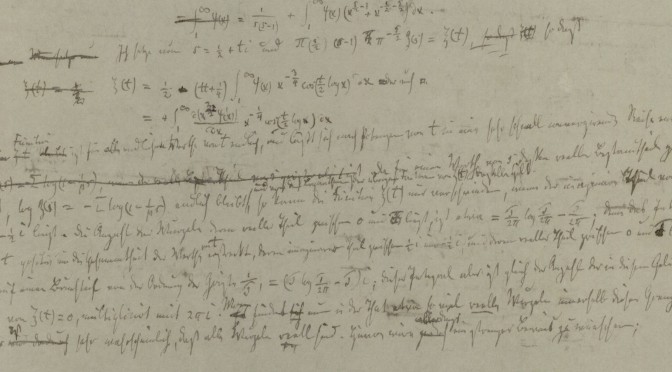Newly (re-)elected department chair Wayne Smith with Varga and our professor emeritus George Csordas in a 1994 paper gave results on the de Bruijn-Newman constant $\Lambda$, where the statement $$\Lambda\le 0$$ is equivalent to the Riemann Hypothesis (some of Riemann’s notes on this shown above). Now in 2018 Terence Tao and Rodgers have shown $$\Lambda\ge 0.$$ Their primary inspiration, judging from the abstract, was Smith et al.’s work:

For each $t \in {\bf R}$, define the entire function $$ H_t(x) := \int_0^\infty e^{tu^2} \Phi(u) \cos(xu)\ du$$ where $\Phi$ is the super-exponentially decaying function $$ \Phi(u) := \sum_{n=1}^\infty (2\pi^2 n^4 e^{9u} – 3\pi n^2 e^{5u} ) \exp(-\pi n^2 e^{4u} ).$$ Newman showed that there exists a finite constant $\Lambda$ (the de Bruijn-Newman constant) such that the zeroes of $H_t$ are all real precisely when $t \geq \Lambda$. The Riemann hypothesis is the equivalent to the assertion $\Lambda \leq 0$, and Newman conjectured the complementary bound $\Lambda \geq 0$.
In this paper we establish Newman’s conjecture. The argument proceeds by assuming for contradiction that $\Lambda < 0$, and then analyzing the dynamics of zeroes of $H_t$ (building on the work of Csordas, Smith, and Varga) to obtain increasingly strong control on the zeroes of $H_t$ in the range $\Lambda< t \leq 0$, until one establishes that the zeroes of $H_0$ are in local equilibrium, in the sense that locally behave (on average) as if they were equally spaced in an arithmetic progression, with gaps staying close to the global average gap size. But this latter claim is inconsistent with the known results about the local distribution of zeroes of the Riemann zeta function, such as the pair correlation estimates of Montgomery.


Nice work, Wayne and George!